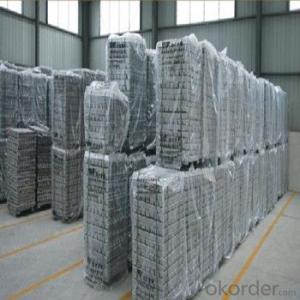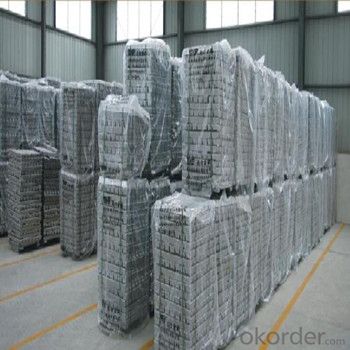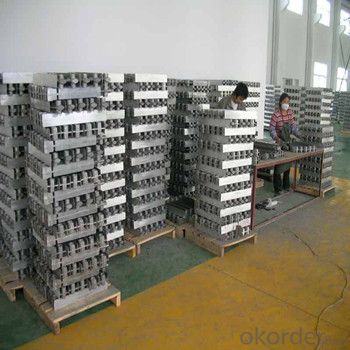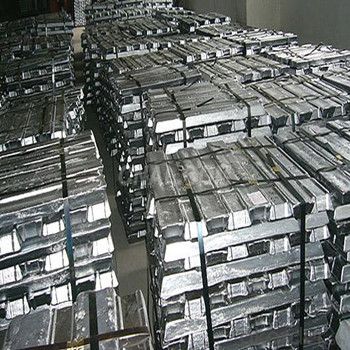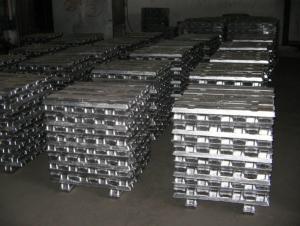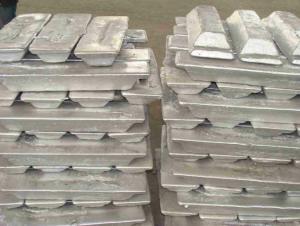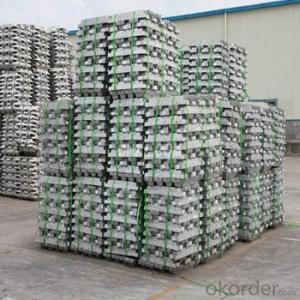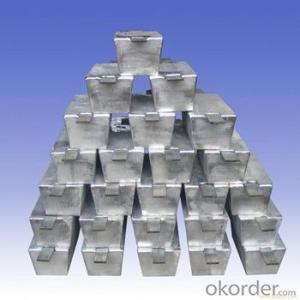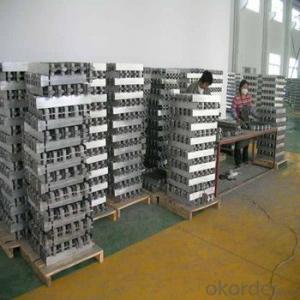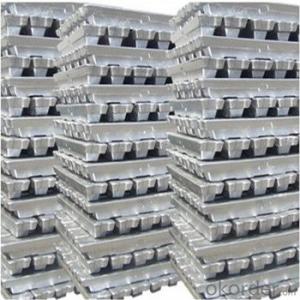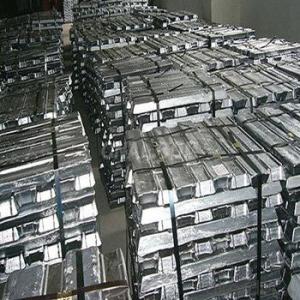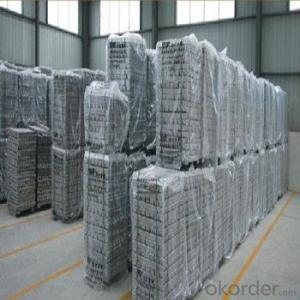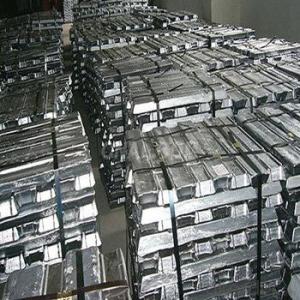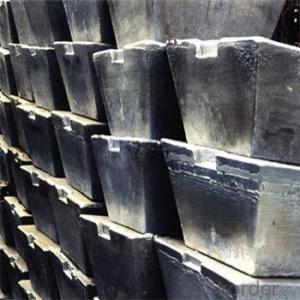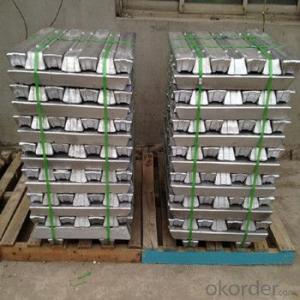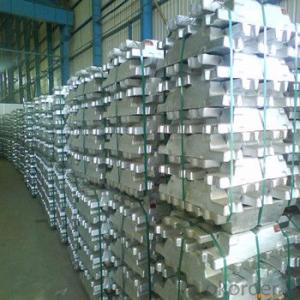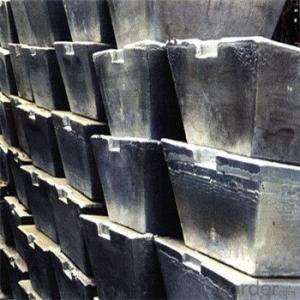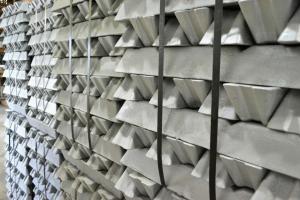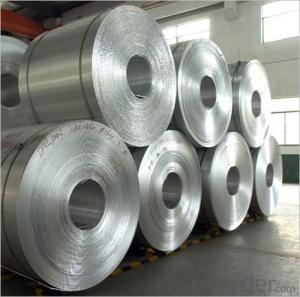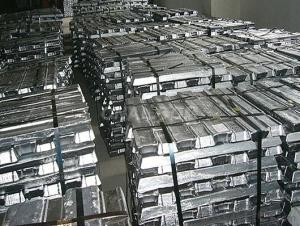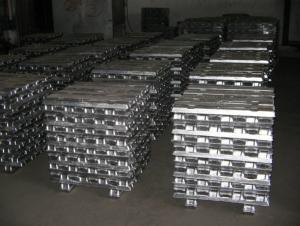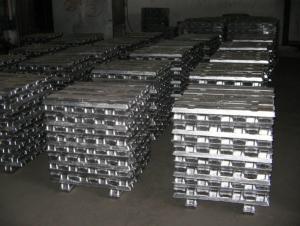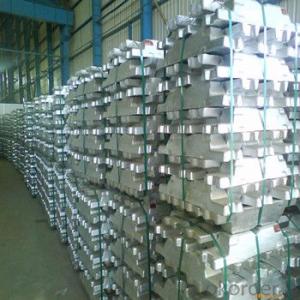Aluminum Ingot From Chinese Supplier Best Quanlity
- Loading Port:
- China main port
- Payment Terms:
- TT OR LC
- Min Order Qty:
- 1000 m.t.
- Supply Capability:
- 10000 m.t./month
OKorder Service Pledge
OKorder Financial Service
You Might Also Like
Pure Aluminum Ingot Used for Industry
1.Structure of Aluminum Ingot Description
An ingot is a piece of material, usually metal, that is cast into a shape suitable for further processing. Insteelmaking, it is the first step among semi-finished casting products.
2.Main Features of the Aluminum Ingot
•Easy control and operation
•Fast melting
•Good price
•Good Service
3. Aluminum Ingot Images
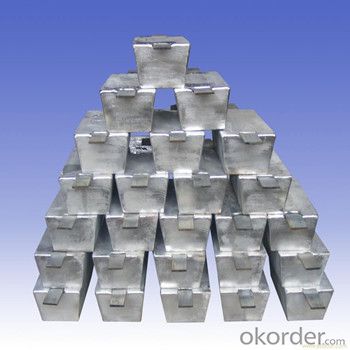
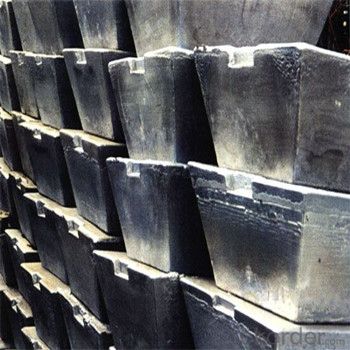
4. Aluminum Ingot Specification
Grade | Chemical Composition % | |||||||||
Al≥ | impurities ≤ | |||||||||
Si | Fe | Cu | Ga | Mg | Zn | Mn | others | Sum | ||
Al99.9 | 99.90 | 0.50 | 0.07 | 0.005 | 0.02 | 0.01 | 0.025 | - | 0.010 | 0.10 |
Al99.85 | 99.85 | 0.80 | 0.12 | 0.005 | 0.03 | 0.02 | 0.030 | - | 0.015 | 0.15 |
Al99.7 | 99.70 | 0.10 | 0.20 | 0.010 | 0.03 | 0.02 | 0.030 | - | 0.030 | 0.30 |
Al99.6 | 99.60 | 0.16 | 0.25 | 0.010 | 0.03 | 0.03 | 0.030 | - | 0.030 | 0.40 |
Al99.5 | 99.50 | 0.22 | 0.30 | 0.020 | 0.03 | 0.05 | 0.050 | - | 0.030 | 0.50 |
Al99.00 | 99.00 | 0.42 | 0.50 | 0.020 | 0.03 | 0.05 | 0.050 | - | 0.050 | 1.00 |
5.FAQ of Aluminum Ingot
We have organized several common questions for our clients,may help you sincerely:
①How about your company?
A world class manufacturer & supplier of castings forging in carbon steel and alloy steel,is one of the large-scale professional investment casting production bases in China,consisting of both casting foundry forging and machining factory. Annually more than 8000 tons Precision casting and forging parts are exported to markets in Europe,America and Japan. OEM casting and forging service available according to customer’s requirements.
②How to guarantee the quality of the products?
We have established the international advanced quality management system,every link from raw material to final product we have strict quality test;We resolutely put an end to unqualified products flowing into the market. At the same time, we will provide necessary follow-up service assurance.
③How long can we receive the product after purchase?
In the purchase of product within three working days, We will arrange the factory delivery as soon as possible. The pecific time of receiving is related to the state and position of customers.Commonly 7 to 10 working days can be served.
- Q: Can aluminum ingots corrode?
- Indeed, it is possible for aluminum ingots to experience corrosion. Despite being renowned for its resistance to corrosion, aluminum is not entirely impervious to it. When subjected to specific environments, like those containing high salt or acid concentrations, aluminum can undergo a process known as oxidation. This process gives rise to the formation of a thin layer of aluminum oxide on the surface of the metal, which serves as a safeguard, preventing further corrosion. Nonetheless, if this protective layer becomes damaged or compromised, the underlying aluminum can become vulnerable to corrosive elements, ultimately resulting in corrosion. Consequently, although aluminum ingots generally display resistance to corrosion, it is crucial to exercise proper caution and take necessary measures to shield them in corrosive surroundings.
- Q: What is the weight of a standard aluminum ingot?
- The weight of a standard aluminum ingot can vary, but it is typically around 50 pounds (22.7 kilograms) or 25 kilograms.
- Q: What are the different welding methods for aluminum ingots?
- Aluminum ingots can be welded using various methods, each offering unique advantages and applications. Some commonly used welding methods for aluminum ingots include: 1. TIG Welding: TIG welding is a popular option for welding aluminum ingots. It utilizes a non-consumable tungsten electrode to create an arc and a shielding gas to protect the weld from atmospheric contamination. TIG welding provides precise and high-quality welds with excellent heat control. It is commonly used in industries like aerospace and automotive, where top-notch welds are essential. 2. MIG Welding: MIG welding is another widely employed method for aluminum ingots. It involves using a consumable wire electrode and a shielding gas to safeguard the weld zone. MIG welding is relatively quicker and easier to learn compared to TIG welding, making it suitable for applications that require high productivity and volume, such as fabrication and manufacturing. However, it may not offer the same level of precision as TIG welding. 3. GMAW: GMAW, also known as MIG welding, is commonly utilized for aluminum ingots. It employs a continuous wire electrode and a shielding gas to protect the weld from atmospheric contamination. GMAW offers high welding speeds and finds extensive use in industries like automotive and construction, where efficiency and productivity are crucial. 4. PAW: PAW is a versatile and precise welding method that can also be used for aluminum ingots. It utilizes a focused plasma arc and a shielding gas for protection. PAW can produce high-quality welds with minimal heat input, making it suitable for thin aluminum sheets or delicate applications. 5. FSW: FSW is a solid-state welding process suitable for aluminum ingots. It involves using a rotating tool to generate friction and heat, which softens the material and enables joining. FSW is particularly beneficial for joining thick or complex aluminum structures, as it reduces the risk of distortion and produces strong, defect-free welds. In summary, the choice of welding method for aluminum ingots depends on factors such as desired weld quality, productivity requirements, material thickness, and specific application. Each method has its own advantages and limitations, and it is crucial to select the most appropriate method based on the specific project requirements.
- Q: How are aluminum ingots used in the production of lighting fixtures?
- Due to their unique properties and versatility, aluminum ingots play a vital role in the manufacturing of lighting fixtures. The lightweight and durability of aluminum make it an ideal material for producing various components of lighting fixtures, such as the body, base, or frame. Its lightweight nature allows for easier installation and transportation, while its durability ensures the fixture's longevity. Furthermore, aluminum's excellent thermal conductivity is crucial for lighting fixtures as it helps dissipate heat generated by the bulbs. This property ensures that the fixture remains cool and prevents overheating, contributing to the safety and efficiency of the lighting system. Moreover, aluminum ingots can be easily molded into different shapes and sizes, allowing for the production of intricate and aesthetically pleasing lighting fixtures. This design flexibility enables manufacturers to cater to various consumer preferences, whether they prefer sleek and modern styles or classic and ornate designs. Moreover, aluminum's high corrosion resistance is particularly important for lighting fixtures that may be exposed to outdoor elements or high levels of moisture. This property guarantees that the fixture remains intact and maintains its appearance even under harsh conditions. Lastly, aluminum ingots are environmentally friendly as they can be easily recycled and have a low carbon footprint compared to other materials. This makes aluminum an appealing choice for lighting fixture manufacturers who prioritize sustainability and seek to reduce their environmental impact. In conclusion, the lightweight, durable, and thermally conductive properties of aluminum ingots, along with their versatility in design and environmental friendliness, make them indispensable in the production of lighting fixtures.
- Q: How many tons of alumina for a ton of aluminum ingot, alumina and electrolytic aluminum what is the difference?
- Electrolytic aluminum is a metallic aluminum refined by electrolysis. It is an aluminum of high purity.
- Q: Aluminum scrap and aluminum ingot in the intermediate frequency aluminum furnace, which is more energy saving?
- Tons of power consumption is basically the same!Theoretically, the aluminum ingot saves electricity.
- Q: Can aluminum ingots be anodized?
- Aluminum ingots are capable of undergoing anodization. Anodization, an electrochemical procedure, yields a safeguarding oxide layer on the exterior of aluminum. This technique can be employed on aluminum ingots, sheets, or any other manifestations. Anodization boasts numerous advantages, including heightened resistance against corrosion, enhanced durability, and the potential to introduce color onto the surface. Moreover, the anodized layer enriches the aesthetic appeal of the aluminum and facilitates superior adhesion of paints or dyes. In summary, the anodization of aluminum ingots is a prevalent practice across diverse industries to augment both the properties and appearance of the metal.
- Q: How are aluminum ingots used in the automotive industry?
- Aluminum ingots are used in the automotive industry primarily for the production of lightweight components, such as engine blocks, cylinder heads, and body panels. This helps to improve fuel efficiency and overall vehicle performance, while also reducing emissions. Additionally, aluminum ingots are utilized in the manufacturing of transmission cases, suspension systems, and other structural parts, contributing to the overall strength and durability of vehicles.
- Q: It can be dissolved aluminum cans, aluminum ingots, need what equipment?
- A lot of cans are iron, not much aluminum.
- Q: Can aluminum ingots be used in the production of jewelry?
- Yes, aluminum ingots can be used in the production of jewelry. However, aluminum is not a commonly used material for jewelry due to its low melting point and softness. It is often used in costume jewelry or as a base metal for plating.
Send your message to us
Aluminum Ingot From Chinese Supplier Best Quanlity
- Loading Port:
- China main port
- Payment Terms:
- TT OR LC
- Min Order Qty:
- 1000 m.t.
- Supply Capability:
- 10000 m.t./month
OKorder Service Pledge
OKorder Financial Service
Similar products
Hot products
Hot Searches
Related keywords
